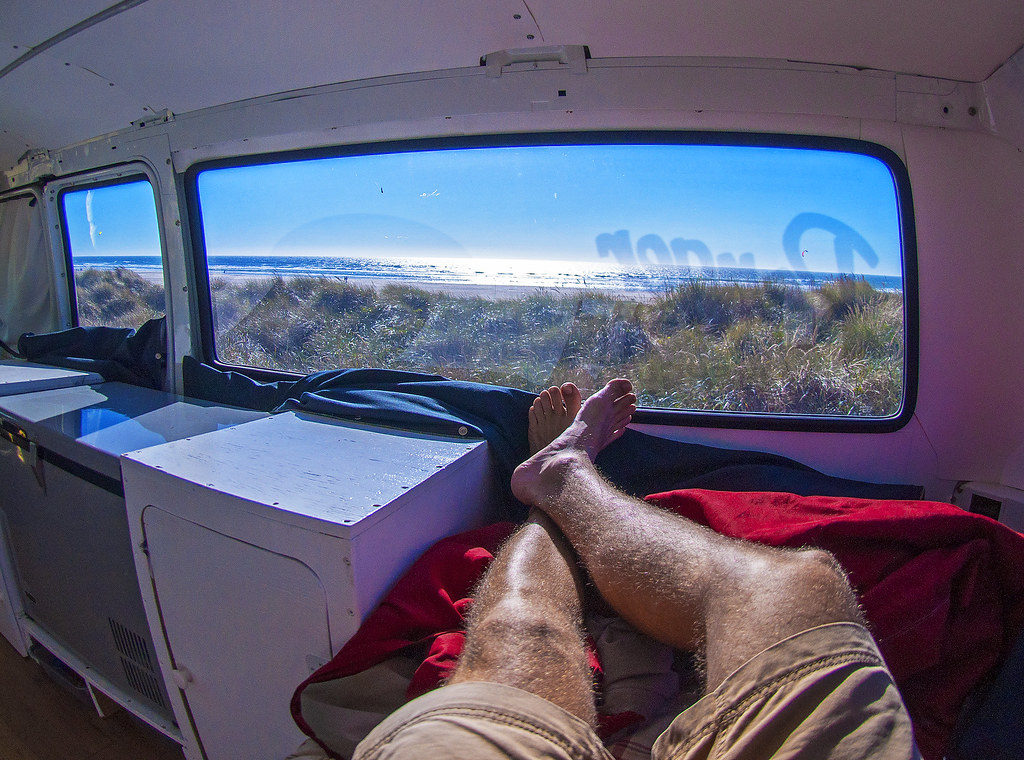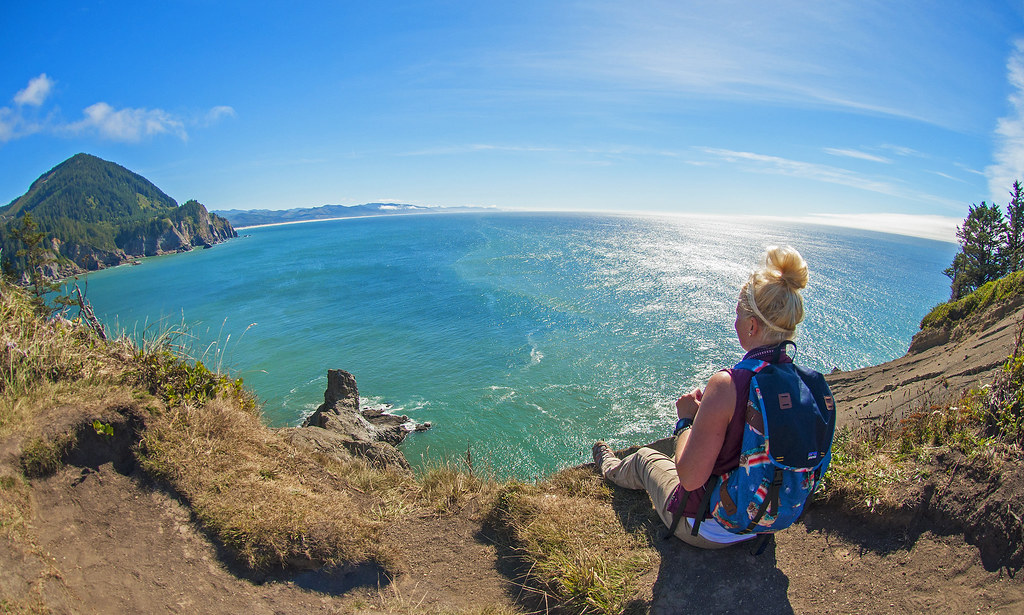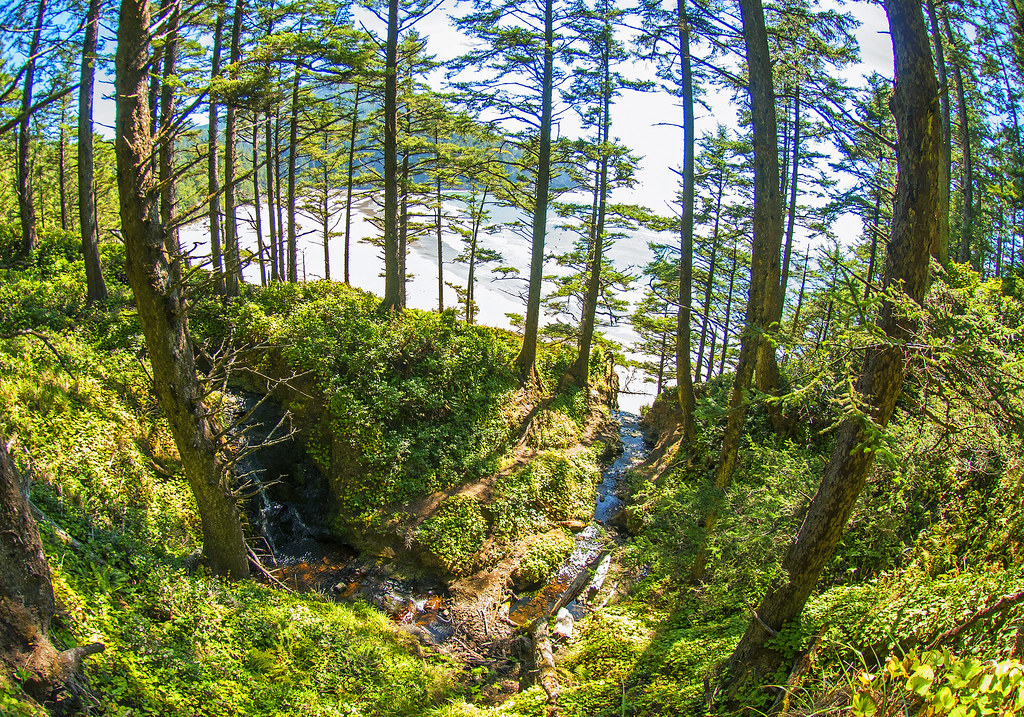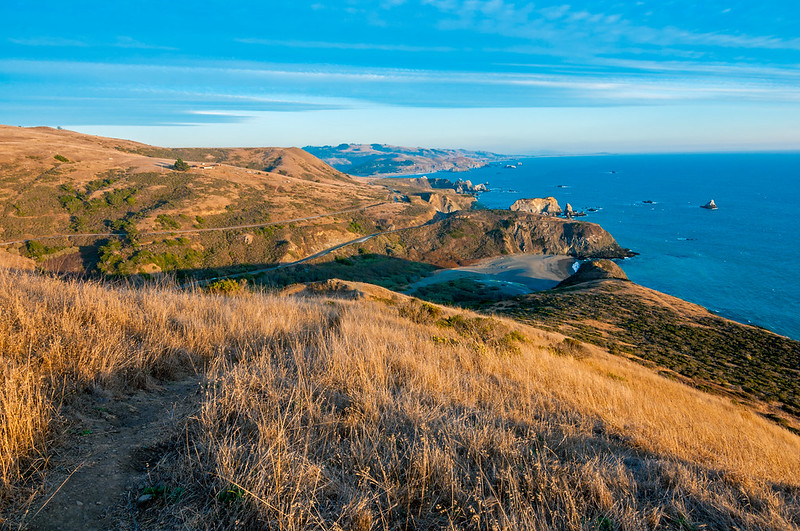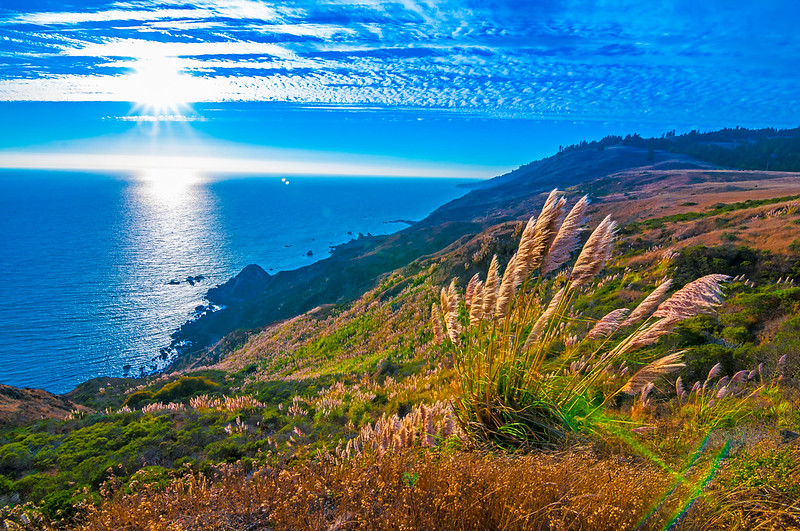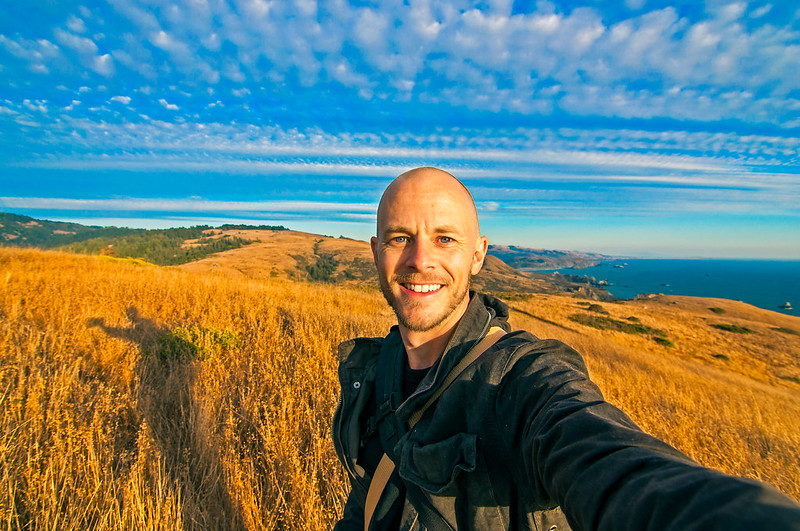You are using an out of date browser. It may not display this or other websites correctly.
You should upgrade or use an alternative browser.
You should upgrade or use an alternative browser.
FALCON'S ODYSSEY
- Thread starter FALCON
- Start date

Help Support Van Living Forum:
This site may earn a commission from merchant affiliate
links, including eBay, Amazon, and others.
FALCON
Well-known member
- Joined
- Mar 28, 2015
- Messages
- 500
- Reaction score
- 0
---------------------------------------------------
PORTLAND
---------------------------------------------------
I spent about a month in and around Portland. I have some old friends that live in a suburb. I spent most of the time with them, barring three or so stints in the city during the week while my friends were mostly busy working.
I haven’t spent this much time with these friends for ten years. It was great. We did a lot together - day trips, going out in the city, bike rides, hikes, a trip to the coast, to a hot spring, to a casino, home/van projects, Monopoly games, etc.
THOUGHTS ON PORTLAND
On my first night inside the city, I met a girl to go on a bike ride together. We were meeting at an intersection, and one of the streets had a significant bike lane in it. This was a Monday, around 5-6pm, so it was rush hour. There were SO MANY people riding by on bikes. There were about 50 people riding by per minute. I’ve never seen so much bike traffic on a normal day, in any city I’ve been in. I did learn that this bike lane functions as sort of a bike freeway, so a lot of bike traffic is funneled through there. But still, it’s a lot. I saw a lot of other people bicycling around town. There are also just a lot of people out and about, walking around. Also, most of them are young. I would’ve guessed that there are a lot more people ages 20-40 in Portland than in other major cities. I did a quick check and it looks like that age range is about 40% of Portland, and 30% of the U.S., so there’s a difference, but not particularly huge. I guess the young people in Portland are just out and about more than other places. Probably part of this phenomenon is that the city is very walkable. There are not wide major roads in the city. There are not strip malls. There are basically sections of streets that have a lot of businesses along them. There are a lot of these little business areas spaced out around the city. People who live near these walk there a lot. In other cities, people get in their car and drive to the Store/Bar/Restaurant that’s in sort of a strip mall.
I like Portland. I was more surprised by how much I like Seattle. I connected with people quicker and deeper in Seattle than Portland. That could just come down to chance, but I have a feeling it’s not.
SO MANY VANDWELLERS
Portland and Seattle have a LOT of people living in vans. Thousands, I believe. They’re all over the place. At each sizable park, there will be 5-10 on the street around the outside. At one intersection in a normal residential area, I looked around and saw 4 vans that look like people may live in them. Parking is super easy in these cities, especially in Portland. If you’re in the city (as long as you’re not in the areas you have to pay, or in certain specific congested areas) it seems you can park however and for however long you want. The direction your vehicle points doesn’t matter. How long you stay parked there doesn’t seem to matter either. Many of the van dwellers appeared to be doing so partly or entirely out of necessity rather than choice.
BUILT SOME SHELVES
There is a vertical wall that makes up the back side of my bike box. The top half of this wall (the outside of the bike box) has been empty so far. I’ve been thinking about adding some more storage either here, or along the top sides of the walls. My buddy helped me, and here’s how it turned out:

We basically build wooden crates that are attached to the wall. I made them as wide as I could without them getting in the way of putting up the curtains (on the left side) or me moving around in the van (on the right sides).

The top 2 are the same depth, and the bottom one is deeper. There is less of a vertical gap between the bottom and middle shelves, so it being wider also helps with reaching in there.
Here you can see the widths:

They currently hold most of my clothes

This freed up other storage space in the plastic shelves. So far, I’ve just thrown my boots and sandals into the drawer that emptied out. One of my rubbermaid containers that’s under the bed is only about 1/3 full right now, so I have some spare room for whatever else I decide to acquire.

$33.63
$39.90
Van Build: A complete DIY guide to designing, converting and self-building your campervan or motorhome
Amazon.com

$79.99
$94.99
DEKOPRO 198 Piece Home Repair Tool Kit, Wrench Plastic Toolbox with General Household Hand Tool Set
Gulin

$30.84
$40.00
The Van Conversion Bible: The Ultimate Guide to Converting a Campervan
Amazon.com

$50.15
$52.99
Mountain House Cooked Diced Chicken | Freeze Dried Survival & Emergency Food | #10 Can | Gluten-Free, 30235-Parent
Amazon.com

$64.91
$99.99
Augason Farms Lunch and Dinner Variety Pail Emergency Food Supply 4-Gallon Pail
Amazon.com

$5.23
$19.95
The Van Life Cookbook: Delicious Recipes, Simple Techniques and Easy Meal Prep for the Road Trip Lifestyle
Natanya's Books

$52.63
$62.99
Mountain House Cooked Ground Beef | Freeze Dried Survival & Emergency Food | #10 Can | Gluten-Free
Amazon.com
FALCON
Well-known member
- Joined
- Mar 28, 2015
- Messages
- 500
- Reaction score
- 0
MORE PICTURES
I added wax to my cotton jacket to make it a lot more water resistant:



A short hike on some island:





I took very few pictures in the city. Portland has some really cool bridges. Maybe next time I’m there I’ll take some good cityscape pictures including the bridges.
Oh, also I bought a used Tokina 11-16mm f2.8 lens. Got it for $300. I’ve been using it almost exclusively and for most landscape pictures, it’s better than the fisheye. I was thinking I would sell the fisheye and 24mm, but I’m not so sure now. There are specific pictures I want to take every now and then that can only be done with the fisheye (or that would take something like a 5mm lens). I’ve also started trying to improve my landscape photography skills. I’ve been reading online and listening to podcasts, and I’m trying to get some books and Lightroom/Photoshop tutorial videos. I figure my mobility and time freedom give me incredibly good opportunities for landscape photography, and I enjoy it, so I might as well get better at it right now.
I haven't processed any of the pictures from Crater Lake or northern CA yet, so those will come later. I drove quickly through Oregon and Northern CA to get down to warmer weather. I'm currently in Santa Cruz and I expect to take it slower from here to Los Angeles
I added wax to my cotton jacket to make it a lot more water resistant:



A short hike on some island:





I took very few pictures in the city. Portland has some really cool bridges. Maybe next time I’m there I’ll take some good cityscape pictures including the bridges.
Oh, also I bought a used Tokina 11-16mm f2.8 lens. Got it for $300. I’ve been using it almost exclusively and for most landscape pictures, it’s better than the fisheye. I was thinking I would sell the fisheye and 24mm, but I’m not so sure now. There are specific pictures I want to take every now and then that can only be done with the fisheye (or that would take something like a 5mm lens). I’ve also started trying to improve my landscape photography skills. I’ve been reading online and listening to podcasts, and I’m trying to get some books and Lightroom/Photoshop tutorial videos. I figure my mobility and time freedom give me incredibly good opportunities for landscape photography, and I enjoy it, so I might as well get better at it right now.
I haven't processed any of the pictures from Crater Lake or northern CA yet, so those will come later. I drove quickly through Oregon and Northern CA to get down to warmer weather. I'm currently in Santa Cruz and I expect to take it slower from here to Los Angeles
WriterMs
Well-known member
Great job of showing not only lovely pics but also what REAL life can be like when one is mobile -- solitary or with friends, in the boonies down by the river of in the middle of a city. Thanks for sharing it all with us.
djkeev
Well-known member
- Joined
- Oct 1, 2016
- Messages
- 506
- Reaction score
- 0
Falcon, awesome posts!
Your journey looks great thus far, I'm just a tad jealous......
You modified a Dodge Van for your camper.
I see that your bed goes side panel to side panel.
Do you by chance know the size of your bed?
I am beginning a similar build in a Dodge Van (2003) and bed orientation is a huge design factor.
Thanks!
Dave
Your journey looks great thus far, I'm just a tad jealous......
You modified a Dodge Van for your camper.
I see that your bed goes side panel to side panel.
Do you by chance know the size of your bed?
I am beginning a similar build in a Dodge Van (2003) and bed orientation is a huge design factor.
Thanks!
Dave
FALCON
Well-known member
- Joined
- Mar 28, 2015
- Messages
- 500
- Reaction score
- 0
Thanks folks 
The mattress is 35"x74". The space between the metal ribs in the back is about 72", but my mattress is foam so it fits in there easily. The space between the walls back there would be about 76", I believe. (I have an inch of insulation on each side plus a pretty thin layer of wood.
djkeev said:You modified a Dodge Van for your camper.
I see that your bed goes side panel to side panel.
Do you by chance know the size of your bed?
I am beginning a similar build in a Dodge Van (2003) and bed orientation is a huge design factor.
The mattress is 35"x74". The space between the metal ribs in the back is about 72", but my mattress is foam so it fits in there easily. The space between the walls back there would be about 76", I believe. (I have an inch of insulation on each side plus a pretty thin layer of wood.
FALCON
Well-known member
- Joined
- Mar 28, 2015
- Messages
- 500
- Reaction score
- 0
DRIVING SOUTH THROUGH OREGON
I stayed in Portland until the end of September, and it was colder than I liked. I’d planned to make my way slowly south through string of National Forests, and make a few stops in hot springs, Smith Rock, Painted Hills, Bend, Crater Lake, etc. But as I checked what the weather would be like, I saw that if I took my sweet time, it would be “too cold” all the way until I got to Southern California. So I drove through Oregon in just two days and skipped all of the planned sites that weren’t right on the way.
In those two days I saw that Oregon has a huge variety of landscape. There is the coast, the lush and heavily treed areas near the coast, the Columbia river gorge, the high desert stuff once you get inland a bit, and I believe some more full-on desert further east. I could easily spend an entire summer exploring Oregon and instead of wishing I was elsewhere, I’d be wishing summer was longer. So… maybe some other time..
Most of my pictures from this point on are using the Tokina 11-16 that I bought in Portland. (The exceptions are some of the Crater lake pictures in this post, and going forward just specific photo types: like the pictures taken inside the van looking out the window, and probably the pictures where I’m sitting down with some view and you can see my legs/feet.). I was thinking I’d sell the fisheye and my 24mm lens right after getting the 11-16. Those two would more recoup what I spent on the Tokina. But I think I’m going to wait. The good thing about these lenses is they go long stretches of time without getting outdated and hold value very well.
On the way to Bagby Hot Springs:



BAGBY HOT SPRINGS
My friends from Portland met me there (and one of them took this)

This was the first hot spring I’ve been to where it’s common to get in the water. It was…. ok. Bagby is a little spring with no natural pool. A wooden building was made with wooden tubs. The water from the spring runs into pipes that go through the building and can be used to fill the tubs. It cost $5 go in. I paid and discovered later that I could’ve easily gotten away without paying, as many people did. For me, it wasn’t worth the $5. It’s a little weird going in tubs where you know thousands of people have been, and it didn’t feel like connecting with nature any more than just sitting down on the ground somewhere.
BEND
Bend seemed really cool. There are a lot of outdoors enthusiasts there. Just outside of town are a TON of biking trails. There are also a lot of Forest Service roads - roads that look like they’d have really good places to camp.
One strange thing about Bend is that while I was there, it smelled bad. The whole city. It smelled the same way cloth does if it has been sitting wet too long and a lot of bacteria has grown. I have no idea what it was from. As I was driving into town I was like “What the hell? Is that me? Is that something in the van?”. Nope. This whole ******* town stinks! (I like Bend though)
CRATER LAKE
I took a nice scenic route out of bend - along the Cascade Lakes Scenic Byway. It goes west out of Bend past Mt. Bachelor, and then south passing by a bunch of lakes.
Some information about Crater Lake:
- It was formed when the insides of a big volcano collapsed about 8,000 years ago. All the sort of capillaries and paths the lava took left a many open voids in the earth and it all caved down on itself.
- It filled up with rainwater. There are out inlets or outlets. The water level stays pretty consistent now. Given normal evaporation and rain, the rate of water replacement would turnover all the lake’s water every 250 years (though surely it doesn’t mix entirely so some of the water sitting in there has been there for nearly 8,000 years.
- The lake is basically circular with a diameter of 5 to 6 miles.
- The deepest part is nearly 2,000 feet.
- It holds 5,000,000,000,000 (5 trillion) gallons of water. That is a lot of water! But in the U.S. alone, so much fresh water is used that if the lake was suddenly supplying all the US, it would be emptied in about ten minutes! (The U.S. pulls 355 trillion gallons of fresh water per day).
- The water is as clear as any lake in the world because it is filled only by direct rainwater (and only a little bit of runoff from the inside edges of the volcano/crater). So there is very little sediment coming into the lake.
- It looks so blue because of how deep it is. Blue light passes through water much better than other colors, so because the light is traveling so far in the lake, all you get is blue coming out. The banks of the lake are really steep so it’s pretty much blue edge to edge.
I didn’t stay long. Just enough to take pictures at a tourist spot and hike up along a nearby ridge. It’s hard to photograph the lake when you’re near it, because it’s so wide. Even my fisheye lens couldn’t really fit it all in. If I come back and spend more time here, I should hike down to the lake surface. You can also ride a boat out and get dropped off on the island. The lake is basically all there is to this National Park.

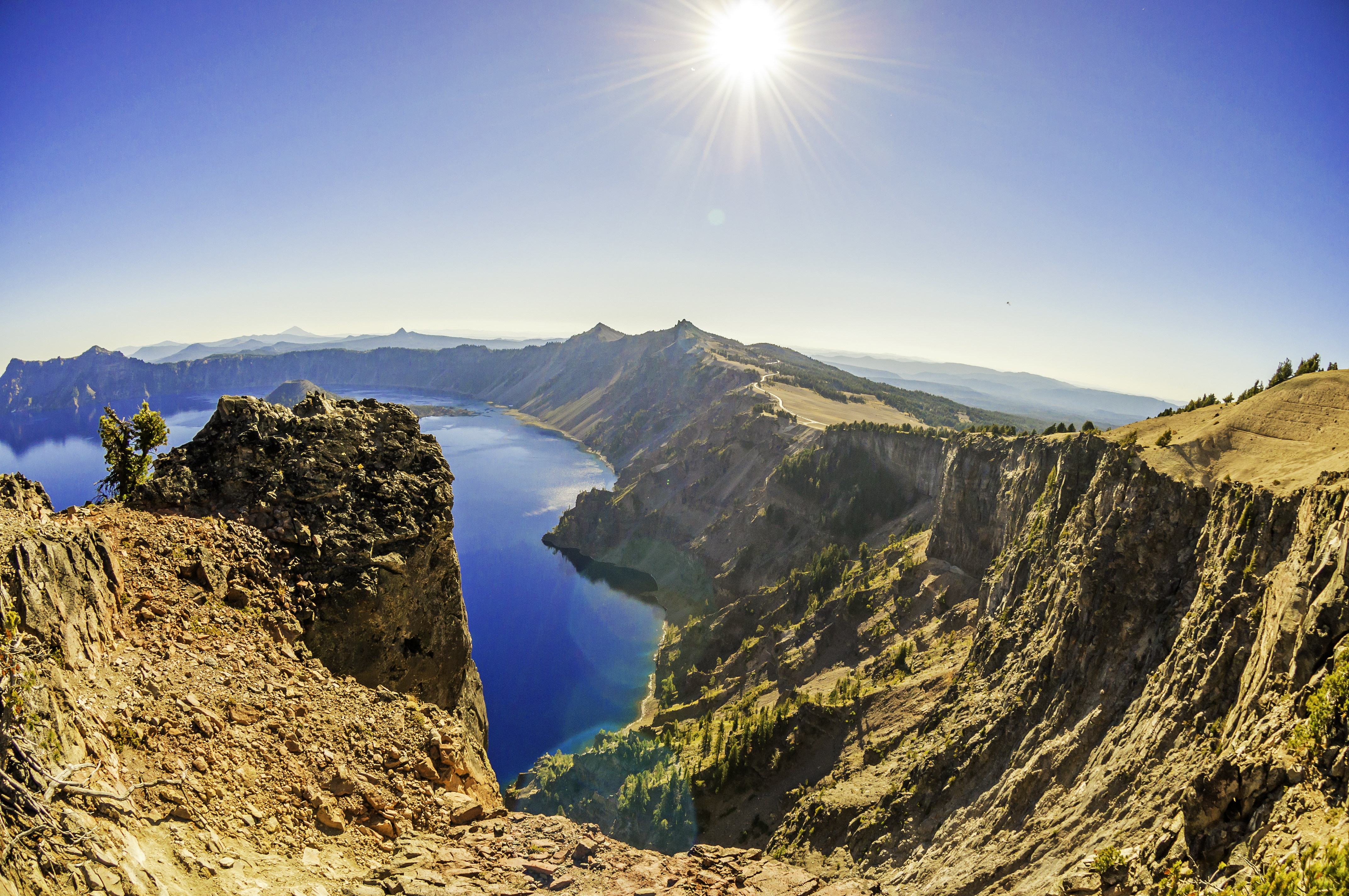

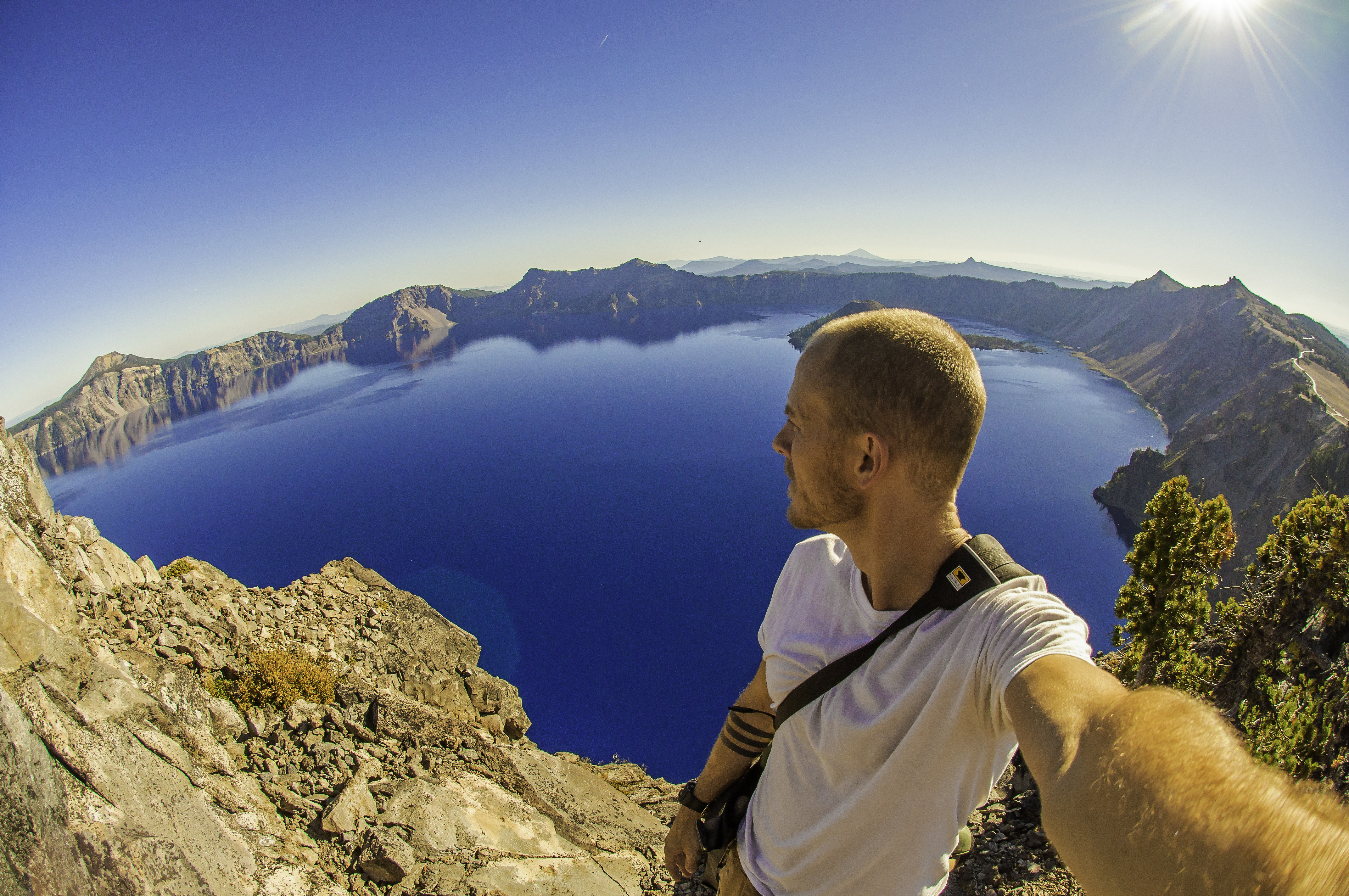


I stayed in Portland until the end of September, and it was colder than I liked. I’d planned to make my way slowly south through string of National Forests, and make a few stops in hot springs, Smith Rock, Painted Hills, Bend, Crater Lake, etc. But as I checked what the weather would be like, I saw that if I took my sweet time, it would be “too cold” all the way until I got to Southern California. So I drove through Oregon in just two days and skipped all of the planned sites that weren’t right on the way.
In those two days I saw that Oregon has a huge variety of landscape. There is the coast, the lush and heavily treed areas near the coast, the Columbia river gorge, the high desert stuff once you get inland a bit, and I believe some more full-on desert further east. I could easily spend an entire summer exploring Oregon and instead of wishing I was elsewhere, I’d be wishing summer was longer. So… maybe some other time..
Most of my pictures from this point on are using the Tokina 11-16 that I bought in Portland. (The exceptions are some of the Crater lake pictures in this post, and going forward just specific photo types: like the pictures taken inside the van looking out the window, and probably the pictures where I’m sitting down with some view and you can see my legs/feet.). I was thinking I’d sell the fisheye and my 24mm lens right after getting the 11-16. Those two would more recoup what I spent on the Tokina. But I think I’m going to wait. The good thing about these lenses is they go long stretches of time without getting outdated and hold value very well.
On the way to Bagby Hot Springs:



BAGBY HOT SPRINGS
My friends from Portland met me there (and one of them took this)

This was the first hot spring I’ve been to where it’s common to get in the water. It was…. ok. Bagby is a little spring with no natural pool. A wooden building was made with wooden tubs. The water from the spring runs into pipes that go through the building and can be used to fill the tubs. It cost $5 go in. I paid and discovered later that I could’ve easily gotten away without paying, as many people did. For me, it wasn’t worth the $5. It’s a little weird going in tubs where you know thousands of people have been, and it didn’t feel like connecting with nature any more than just sitting down on the ground somewhere.
BEND
Bend seemed really cool. There are a lot of outdoors enthusiasts there. Just outside of town are a TON of biking trails. There are also a lot of Forest Service roads - roads that look like they’d have really good places to camp.
One strange thing about Bend is that while I was there, it smelled bad. The whole city. It smelled the same way cloth does if it has been sitting wet too long and a lot of bacteria has grown. I have no idea what it was from. As I was driving into town I was like “What the hell? Is that me? Is that something in the van?”. Nope. This whole ******* town stinks! (I like Bend though)
CRATER LAKE
I took a nice scenic route out of bend - along the Cascade Lakes Scenic Byway. It goes west out of Bend past Mt. Bachelor, and then south passing by a bunch of lakes.
Some information about Crater Lake:
- It was formed when the insides of a big volcano collapsed about 8,000 years ago. All the sort of capillaries and paths the lava took left a many open voids in the earth and it all caved down on itself.
- It filled up with rainwater. There are out inlets or outlets. The water level stays pretty consistent now. Given normal evaporation and rain, the rate of water replacement would turnover all the lake’s water every 250 years (though surely it doesn’t mix entirely so some of the water sitting in there has been there for nearly 8,000 years.
- The lake is basically circular with a diameter of 5 to 6 miles.
- The deepest part is nearly 2,000 feet.
- It holds 5,000,000,000,000 (5 trillion) gallons of water. That is a lot of water! But in the U.S. alone, so much fresh water is used that if the lake was suddenly supplying all the US, it would be emptied in about ten minutes! (The U.S. pulls 355 trillion gallons of fresh water per day).
- The water is as clear as any lake in the world because it is filled only by direct rainwater (and only a little bit of runoff from the inside edges of the volcano/crater). So there is very little sediment coming into the lake.
- It looks so blue because of how deep it is. Blue light passes through water much better than other colors, so because the light is traveling so far in the lake, all you get is blue coming out. The banks of the lake are really steep so it’s pretty much blue edge to edge.
I didn’t stay long. Just enough to take pictures at a tourist spot and hike up along a nearby ridge. It’s hard to photograph the lake when you’re near it, because it’s so wide. Even my fisheye lens couldn’t really fit it all in. If I come back and spend more time here, I should hike down to the lake surface. You can also ride a boat out and get dropped off on the island. The lake is basically all there is to this National Park.






FALCON
Well-known member
- Joined
- Mar 28, 2015
- Messages
- 500
- Reaction score
- 0
(Continued)



Driving - just outside Crater Lake National Park:



Here is the route I took from Portland to Crescent City




Driving - just outside Crater Lake National Park:



Here is the route I took from Portland to Crescent City

FALCON
Well-known member
- Joined
- Mar 28, 2015
- Messages
- 500
- Reaction score
- 0
Northern California, Part 1
I covered this stretch in just a few days:

I’d hurried to Crescent City, CA - which is basically the northernmost town along the California coast. From there, I would start my meandering down the entire California coast. This is the most popular and desired road trip in America. The most beautiful highway. The exclamation point on the western edge of the United States. The manifest destiny fulfilled.
Climate-wise, I got down to Crescent City later than I should’ve. It was cold. So I moved south to and through San Francisco quickly - in a week or less. Once I got past San Francisco, I stopped to pause in some towns - mainly Santa Cruz and Carmel-By-The-Sea. But basically, I went quickly down to Carmel and then paused for about 5 days before going through Big Sur.
The California coast is a difficult place to live in a van. There are some long stretches without towns big enough to blend in or even park off the highway. From the border to Big Sur there are no National Forests. I’ll cover Big Sur in a future post, but the National Forest at Big Sur is closed entirely because of a big fire. Normally that would be a great place to pause for quite a while and go between the coast and campsites in the Forest.
Many days I drove south in chunks of about 150 miles. That would take me a long time because I’d stop a lot to walk around, relax, and take pictures.
AVENUE OF THE GIANTS
This is a really cool stretch of 20 or 30 miles. The original highway 1 was rebuilt at some point. Avenue of the Giants is a stretch of the original Highway 1 that was kept and is still maintained (and is now highway 258). The new highway runs basically parallel to the old, but the old passes through a number of redwood groves:

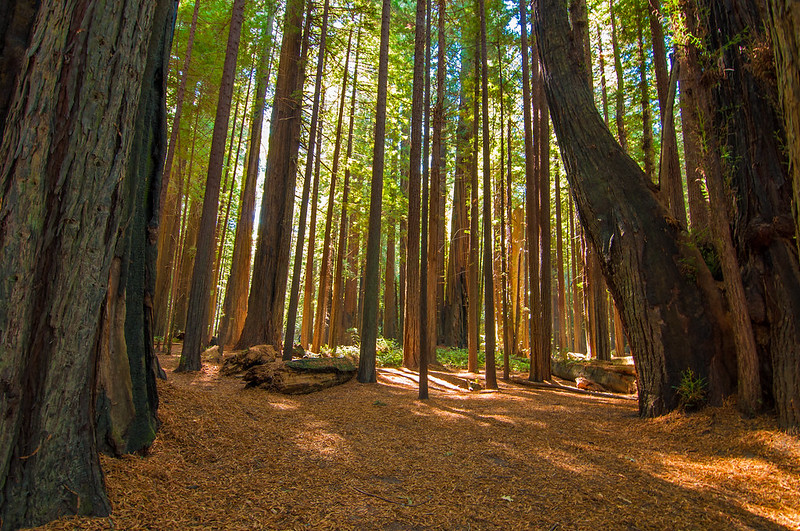




FALCON
Well-known member
- Joined
- Mar 28, 2015
- Messages
- 500
- Reaction score
- 0
BIKE RIDE SURPRISE
One morning, I was parked at one of the little turnouts/parking lots next to the road that overlook the coast. I had breakfast and was doing whatever, and I noticed a lot of people bicycling on the highway. So far the only cyclists I’d seen on the highway were bicycle tourers. At first I figured there were people riding was because it was Saturday. There were so many that I decided it would be a good (safe) day for me to ride along the highway. As I was getting myself and my bike ready to ride, I realized that this was a large organized event.
There are a lot of cycling events where people pay money to ride ($30-$100), and some person/group organizes it - they get routes planned and mark them with signs on the road, they hire police where needed to direct traffic / encourage drivers to drive safely and not road rage on the cyclists / set up food stations at various points along the routes / get “marshall” riders - who know the area and route and who ride along and will help people as needed. I joined the ride and had a whole string of good luck:
1 - They were riding south, so I also went that way. 200 meters from where I started, the route turned left to go inland. That morning I had actually driven back north from the little town I slept in. If I hadn’t done that, or hadn’t driven as far north, I never would’ve seen the riders.
2 - As soon as we turned onto the road inland, it went up a big, fairly long hill. A ride like this includes a lot of old guys and people who don’t ride a ton, so I was passing nearly everyone. One thing I noticed about this ride is that there were a LOT of ride marshalls (they all had bright orange/yellow jerseys identifying them). Only two people passed me going up the hill, and the second one was a marshall. I had been wondering where the route was going. These rides include really long routes (up to 100 or even 150 miles). I’m not in the greatest shape and there’s no point in riding really far, so I needed to figure out how to get back to the van. I didn’t want to just turn around and go down the same road because there were so many riders coming up that me going down against them all would be kind of unsafe. So I rode along behind this marshall for a while and then asked him about the route. This marshall was the only person I spoke to on the ride.
3 - He told me about the route and which turns I should make to get back to the van. He also told me about the event, and explained that it was put on by a guy named Levi Leipheimer, who was a top level pro racer for many years. He said there were a couple other pros here - Jen Ulrich (a very very good rider from Germany. He won the Tour De France once or more and then was 2nd place behind Armstrong like 4 times), plus a current pro named Andrew Telansky. He said they were riding on an entirely different route than we were. Then we were talking about my bike. I have a cyclocross bike, not a normal road bike. I got this bike so I could ride more comfortably on gravel/dirt/rough roads and trails. He said there’s actually a gravel road, a shorter path back, and that he was thinking about taking this route. So, I stayed with him. When we got to the gravel road, he pointed it out for me and decided that he’d go this way. It was more of a trail than a road, and was a really fun. It was all downhill, mostly going through thick trees/forest.
4 - We were going the opposite direction of the route. Since we were going backwards, it was sometimes a little surprising or confusing for the riders that were going the normal way. (This gravel road was part of a really long/challenging route, and there weren’t very many riders on it, probably 3% as many riders as the route I had been on initially). Sometimes we’d pass a person and they would ask if we were ok, or they’d as if they were going the right direction. Since this was a tough route, the guys we were passing were quite fit, and some of them were going up the hill really quickly. We passes one group of three riders and the first one asked if we were ok. The marshall tells me “Hey, that was Levi Leipheimer!”. Then we pass another guy - this one was Andrew Telansky and was recognizable because he still races and thus had his team clothes on. We also figured that the third rider behind Leipheimer must have been Jan Ulrich. You folks reading this have probably never heard of these guys, but they are huge stars. This is sort of like going to a local pick-up football game and seeing John Elway and Randy Moss playing there (though not exactly, because they were there to promote the event).
So anyways, that was a pretty cool string of unexpected and lucky turns.

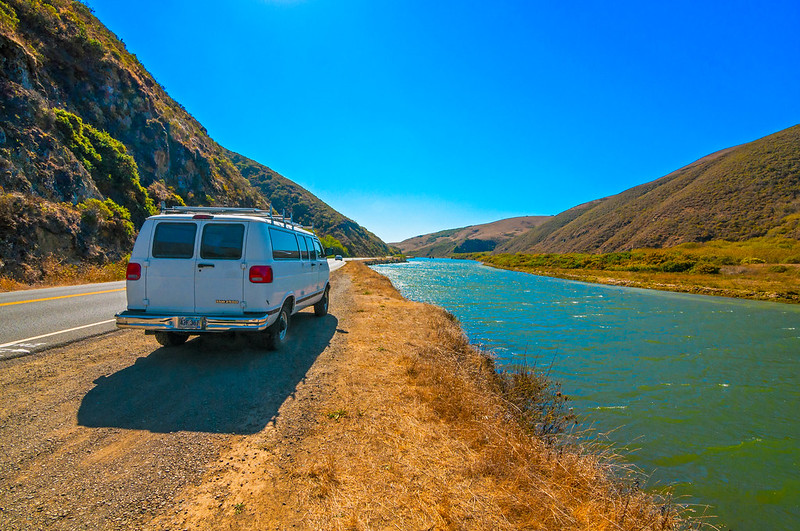

One day I was in a little parking lot off the road. There was a pretty nice beach down a path from this lot. Another van pulled in (A Dodge high top conversion van), and a guy with an accent came over to my van and asked me if I minded him taking a shower over by his van, and how far it was to the beach. I spoke with one of them a bit more later on, and then they invited me to have lunch with them. The guy (Omar) is from Spain, and the woman (Laura) is from France. They had flown into San Francisco within the lat week, and found and bought their van a few days ago. They found a nice deal: $2,500 for a good condition van with 90k miles in San Francisco. They are both world travels and actually met fairly recently at a free outdoor Rolling Stones concert in Cuba. They were quite new to van dwelling and had some technical questions that I was able to help them with. Of course, we had wine with lunch . Before leaving I asked to take a picture:
. Before leaving I asked to take a picture:
Omar joked a few times about being together 24 hours a day and getting a bit tired of each other. When they came over for the picture, instead of standing together, Laura claimed ownership of my van:

And Omar volunteered to take a picture of me:

One morning, I was parked at one of the little turnouts/parking lots next to the road that overlook the coast. I had breakfast and was doing whatever, and I noticed a lot of people bicycling on the highway. So far the only cyclists I’d seen on the highway were bicycle tourers. At first I figured there were people riding was because it was Saturday. There were so many that I decided it would be a good (safe) day for me to ride along the highway. As I was getting myself and my bike ready to ride, I realized that this was a large organized event.
There are a lot of cycling events where people pay money to ride ($30-$100), and some person/group organizes it - they get routes planned and mark them with signs on the road, they hire police where needed to direct traffic / encourage drivers to drive safely and not road rage on the cyclists / set up food stations at various points along the routes / get “marshall” riders - who know the area and route and who ride along and will help people as needed. I joined the ride and had a whole string of good luck:
1 - They were riding south, so I also went that way. 200 meters from where I started, the route turned left to go inland. That morning I had actually driven back north from the little town I slept in. If I hadn’t done that, or hadn’t driven as far north, I never would’ve seen the riders.
2 - As soon as we turned onto the road inland, it went up a big, fairly long hill. A ride like this includes a lot of old guys and people who don’t ride a ton, so I was passing nearly everyone. One thing I noticed about this ride is that there were a LOT of ride marshalls (they all had bright orange/yellow jerseys identifying them). Only two people passed me going up the hill, and the second one was a marshall. I had been wondering where the route was going. These rides include really long routes (up to 100 or even 150 miles). I’m not in the greatest shape and there’s no point in riding really far, so I needed to figure out how to get back to the van. I didn’t want to just turn around and go down the same road because there were so many riders coming up that me going down against them all would be kind of unsafe. So I rode along behind this marshall for a while and then asked him about the route. This marshall was the only person I spoke to on the ride.
3 - He told me about the route and which turns I should make to get back to the van. He also told me about the event, and explained that it was put on by a guy named Levi Leipheimer, who was a top level pro racer for many years. He said there were a couple other pros here - Jen Ulrich (a very very good rider from Germany. He won the Tour De France once or more and then was 2nd place behind Armstrong like 4 times), plus a current pro named Andrew Telansky. He said they were riding on an entirely different route than we were. Then we were talking about my bike. I have a cyclocross bike, not a normal road bike. I got this bike so I could ride more comfortably on gravel/dirt/rough roads and trails. He said there’s actually a gravel road, a shorter path back, and that he was thinking about taking this route. So, I stayed with him. When we got to the gravel road, he pointed it out for me and decided that he’d go this way. It was more of a trail than a road, and was a really fun. It was all downhill, mostly going through thick trees/forest.
4 - We were going the opposite direction of the route. Since we were going backwards, it was sometimes a little surprising or confusing for the riders that were going the normal way. (This gravel road was part of a really long/challenging route, and there weren’t very many riders on it, probably 3% as many riders as the route I had been on initially). Sometimes we’d pass a person and they would ask if we were ok, or they’d as if they were going the right direction. Since this was a tough route, the guys we were passing were quite fit, and some of them were going up the hill really quickly. We passes one group of three riders and the first one asked if we were ok. The marshall tells me “Hey, that was Levi Leipheimer!”. Then we pass another guy - this one was Andrew Telansky and was recognizable because he still races and thus had his team clothes on. We also figured that the third rider behind Leipheimer must have been Jan Ulrich. You folks reading this have probably never heard of these guys, but they are huge stars. This is sort of like going to a local pick-up football game and seeing John Elway and Randy Moss playing there (though not exactly, because they were there to promote the event).
So anyways, that was a pretty cool string of unexpected and lucky turns.



One day I was in a little parking lot off the road. There was a pretty nice beach down a path from this lot. Another van pulled in (A Dodge high top conversion van), and a guy with an accent came over to my van and asked me if I minded him taking a shower over by his van, and how far it was to the beach. I spoke with one of them a bit more later on, and then they invited me to have lunch with them. The guy (Omar) is from Spain, and the woman (Laura) is from France. They had flown into San Francisco within the lat week, and found and bought their van a few days ago. They found a nice deal: $2,500 for a good condition van with 90k miles in San Francisco. They are both world travels and actually met fairly recently at a free outdoor Rolling Stones concert in Cuba. They were quite new to van dwelling and had some technical questions that I was able to help them with. Of course, we had wine with lunch
Omar joked a few times about being together 24 hours a day and getting a bit tired of each other. When they came over for the picture, instead of standing together, Laura claimed ownership of my van:

And Omar volunteered to take a picture of me:

FALCON
Well-known member
- Joined
- Mar 28, 2015
- Messages
- 500
- Reaction score
- 0
CA - San Francisco to Big Sur
I only spent a couple days in the San Francisco area. I had been driving a lot, and I had spent most of the last two months in cities. I wasn’t excited about hanging around another dense city. Especially one as dense as San Francisco. I drove across the Golden Gate bridge in the evening on a Saturday (on which I saw signs that it would cost me $7 or something, I assume I’ll get a bill in the mail). The city was PACKED. There was a ton of traffic. Cars everywhere. Almost nowhere to park on the street. So I drove through the city and 5-10 miles into the suburbs. It was easier to park, but the streets were still packed full down there. I was in no mood to search and fight for parking spots.
The next day, a girl told me about a huge free music festival going on: in Golden Gate Park: Hardly Strictly Bluegrass. What? A bluegrass music festival?! Sweet. Well, I happened to drive right by where it was happening and that explained part of why it was so busy. So on Sunday I drove back up there and went to the festival. It was cool. I think they should change the title from “Hardly Strictly Bluegrass” to “Barely any Bluegrass” though. It was great people watching. I haven’t seen this many hipsters since leaving St Louis. I saw more cans of PBR and PBR shirts than I ever have in one place before. People had their most stylish and weird hippie/hipster/festival outfits on. The park rules about bringing in alcohol, and especially selling it, are quite strict and tough sounding, so I was a tiny bit worried about the flask I was bringing it (wondering if they might have an entrance where they search people - although frisking would still be unlikely). But upon arriving it was obviously more of an anything-goes event. Some of the more enterprising hipsters were walking around with coolers or cases of beer and selling them for $5 and up per can. One of the funniest things I remember from that day was seeing a woman and child talking as I was walking by. The child was obviously not hers, it seemed like they didn’t really know eachother. There was one of those big fat bees on the woman’s hand, and they were both looking at it. As I pass by, I hear the boy ask, entirely seriously: “Is that your pet?”. I loved that kind of imaginative open-mindedness. Another thing I saw was a very bohemian looking guy walking with a basket. In the basket was a very fluffy rabbit. One woman, quite polished and preppy looking, saw the rabbit and just reached out to pet it. The guy pulled in the basket to his chest and maybe even turned away or put up an arm to block her. This was probably a woman not used to being physically rejected so immediately, but she seemed to take it ok. A couple seconds and about 10 feet of walking later, another woman, more hippie-ish, saw the rabbit and asked to pet it. The guy was happy to let her.
So, take note, if you want to meet girls at a festival, the rabbit strategy looks very effective.
Anyways, the music was good. I left a couple hours before the end and got the hell out of San Francisco.

COWELL RANCH BEACH
One of the fancy little towns just a bit south of San Francisco is Half-Moon Bay. A bit south of HMB is Cowell Ranch Beach. This is a REALLY nice beach! The area is basically just the beach and a parking lot 1/2 mile from the beach. The parking lot is small - room for about ten cars. I pulled in around noon on a weekday. In the parking lot, there were 3 black Lincoln Navigators and 3 black Mercedes, and most of them had a guy in a suit sitting in the driver's seat. Ok, looks like some spendy people hired fancy cars to take them to this beach. I figured it was either a wedding, or some silicon valley company outing. When I went down to the beach, I saw a family - just 4-5 people. They had a nice setup on the beach. Canopy things. Tables and chairs. At the back of the beach were boxes /containers of stuff, and a guy sitting or standing there. The family Patriarch waved at the guy and he jumped up, grabbed a camera that was sitting on one of the boxes, and ran over towards the family - ok, this was their personal photographer. There were no other people around. The beach has ends that would not be hard to walk past. There was a trail that left from the top, where these pictures were also taken from, but that trail is only open on weekends and it was gated closed. So I was wondering why there were 5-6 cars for this small amount of people. When I started heading back for lunch, it looked like the family was done back there and would come back soon. They did, and then all the cars, bit by bit, left. (I couldn't see where they got in the cars, it was sort of around a corner from me). Anyways, I hung out there the rest of the afternoon and took these pictures at sunset
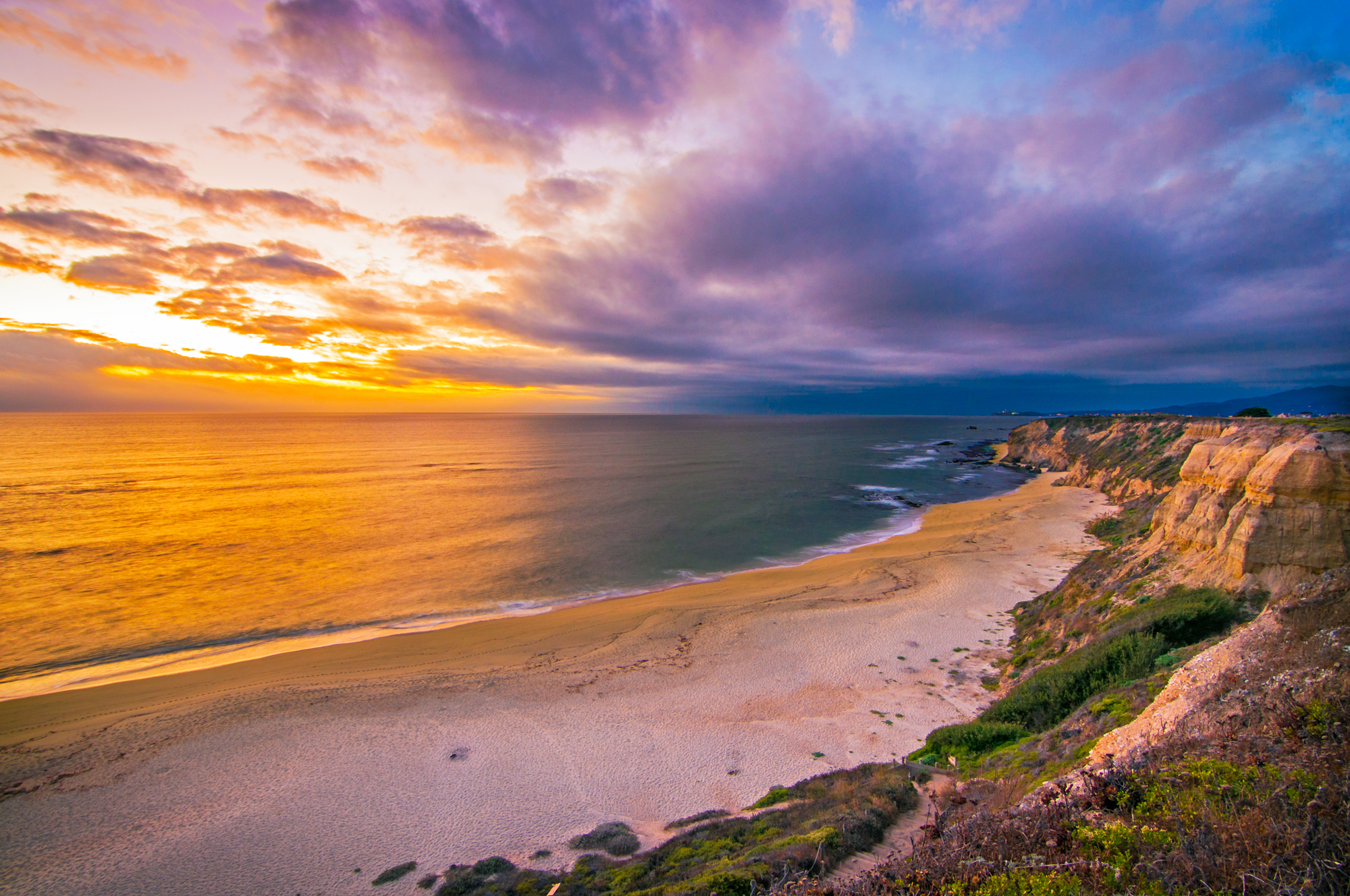
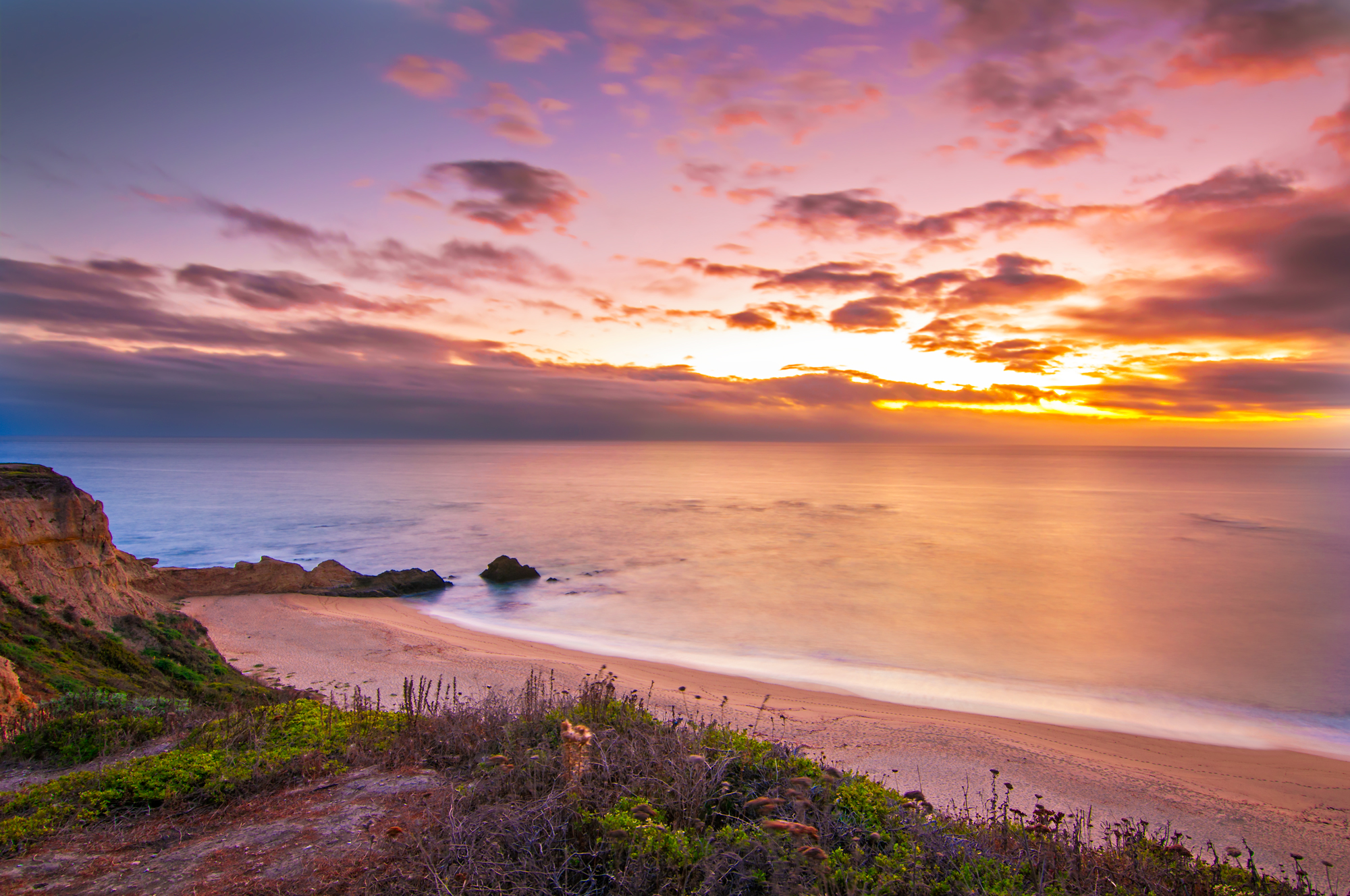

I’ve recently started trying to make better landscape photographs, and I’m making some progress :-D.
I stopped for a few days in Santa Cruz and that seems like a nice enough place. I also stopped a bit in Monterey.
FALCON
Well-known member
- Joined
- Mar 28, 2015
- Messages
- 500
- Reaction score
- 0
CARMEL-BY-THE-SEA
Carmel is a really fancy little town. I spent 5 or so days here. Parking in Carmel could seem tricky because in all the residential areas, there are signs saying you can’t park overnight unless you have some permit. But in the downtown area, there are no permits required, it’s just 2 hour parking from 8am to 6pm. You can park at the beach all day long, and you just can’t park there from midnight to 6am. So my daily routine was like this:
- Wake up, drive van from where it’s parked downtown to the beach. It’s about a 1/4 mile away and there’s a parking lot right at the beach.
- Have breakfast. Do whatever - read, computer stuff, etc.
- Walk around on the beach
- Work out (bodyweight strength training)
- Maybe take a nap
- Take some pictures if there are clouds when the sun is setting.
- After it’s dark, drive van and find a spot on a quiet street downtown
The 5th or so night, I was a bit more daring that I should be and I parked on the main street downtown. The cops came and knocked on the van at 11pm to tell me that there is no camping allowed in the city. He suggested I go park in a shopping center that’s on the edge of town (there’s a Safeway, starbucks, gas station, etc.). He said that I’ll probably see some other vans/campers parked, and that the cops won’t bother me there.


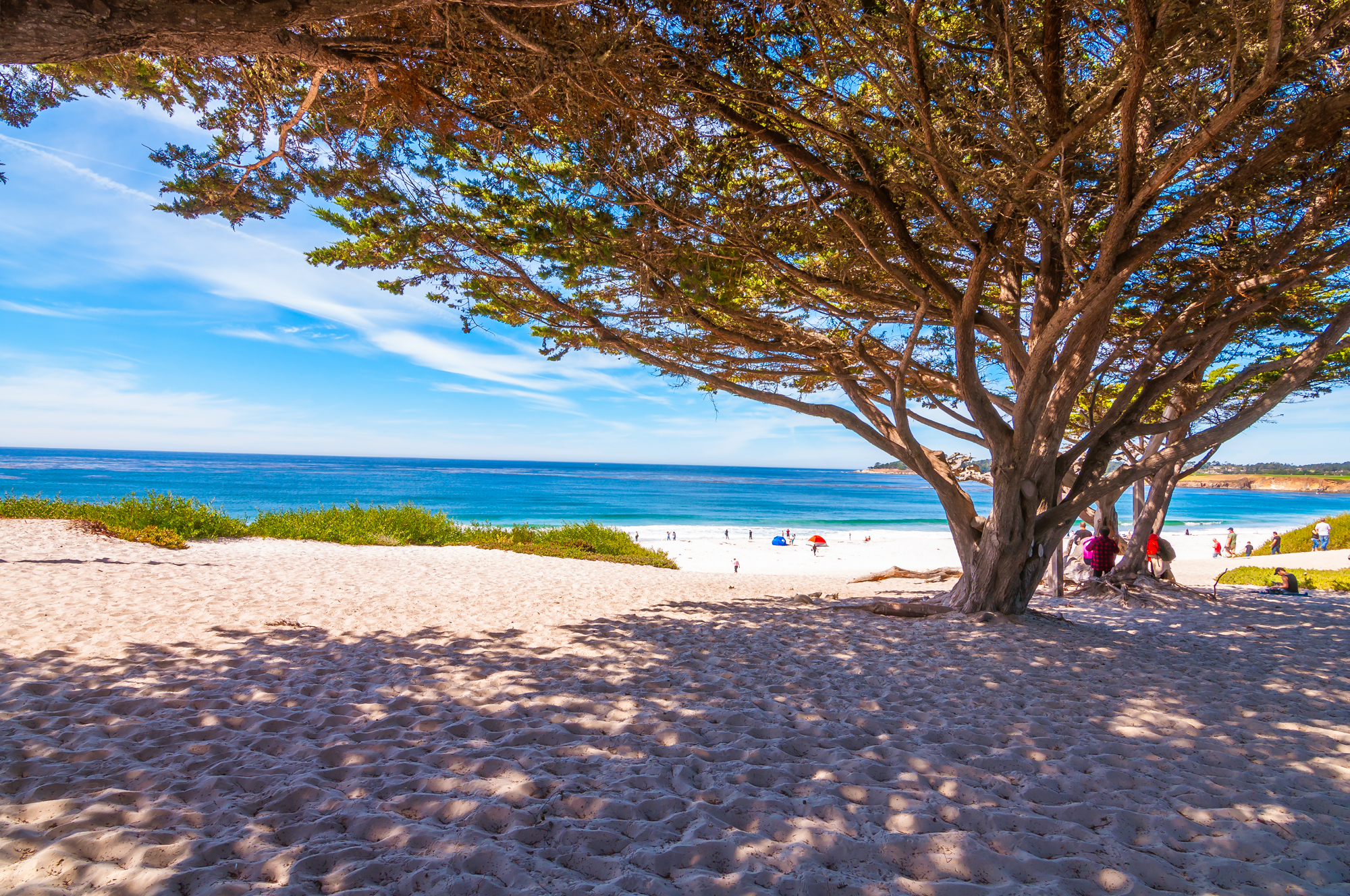


Carmel is a really fancy little town. I spent 5 or so days here. Parking in Carmel could seem tricky because in all the residential areas, there are signs saying you can’t park overnight unless you have some permit. But in the downtown area, there are no permits required, it’s just 2 hour parking from 8am to 6pm. You can park at the beach all day long, and you just can’t park there from midnight to 6am. So my daily routine was like this:
- Wake up, drive van from where it’s parked downtown to the beach. It’s about a 1/4 mile away and there’s a parking lot right at the beach.
- Have breakfast. Do whatever - read, computer stuff, etc.
- Walk around on the beach
- Work out (bodyweight strength training)
- Maybe take a nap
- Take some pictures if there are clouds when the sun is setting.
- After it’s dark, drive van and find a spot on a quiet street downtown
The 5th or so night, I was a bit more daring that I should be and I parked on the main street downtown. The cops came and knocked on the van at 11pm to tell me that there is no camping allowed in the city. He suggested I go park in a shopping center that’s on the edge of town (there’s a Safeway, starbucks, gas station, etc.). He said that I’ll probably see some other vans/campers parked, and that the cops won’t bother me there.





FALCON
Well-known member
- Joined
- Mar 28, 2015
- Messages
- 500
- Reaction score
- 0
(Carmel, continued)
There were really only clouds and a sunset one night. Another night that I felt like taking pictures, I walked along the beach to look for subjects.

There were only clouds and a sunset one night. A different evening I felt like shooting, so I walked along the beach looking for subjects. The beach here in the town is really long, and there were many people out. There was no one in the water except for these two kids: the only people with the kind of excitement about life that it takes to brave the cold Pacific. And they were in the water a long time.
They were about knee deep in the water, but they were small enough and the waves big enough that they were knocked over by some. They always stayed near eachother. When they saw a big wave approaching they'd hold hands so they could feel the wave crashing into them but not fall down with it. This is my favorite picture I've taken in years.

A Ferrari is not out of place in Carmel. I thought it was interesting:
The Ferrari probably cost more then $150,000. I’d guess it’s used 5 hours per month. The van cost $15,000 (to purchase and build out). I use it about 500 hours per month. To each his own.


There were really only clouds and a sunset one night. Another night that I felt like taking pictures, I walked along the beach to look for subjects.

There were only clouds and a sunset one night. A different evening I felt like shooting, so I walked along the beach looking for subjects. The beach here in the town is really long, and there were many people out. There was no one in the water except for these two kids: the only people with the kind of excitement about life that it takes to brave the cold Pacific. And they were in the water a long time.
They were about knee deep in the water, but they were small enough and the waves big enough that they were knocked over by some. They always stayed near eachother. When they saw a big wave approaching they'd hold hands so they could feel the wave crashing into them but not fall down with it. This is my favorite picture I've taken in years.

A Ferrari is not out of place in Carmel. I thought it was interesting:
The Ferrari probably cost more then $150,000. I’d guess it’s used 5 hours per month. The van cost $15,000 (to purchase and build out). I use it about 500 hours per month. To each his own.






